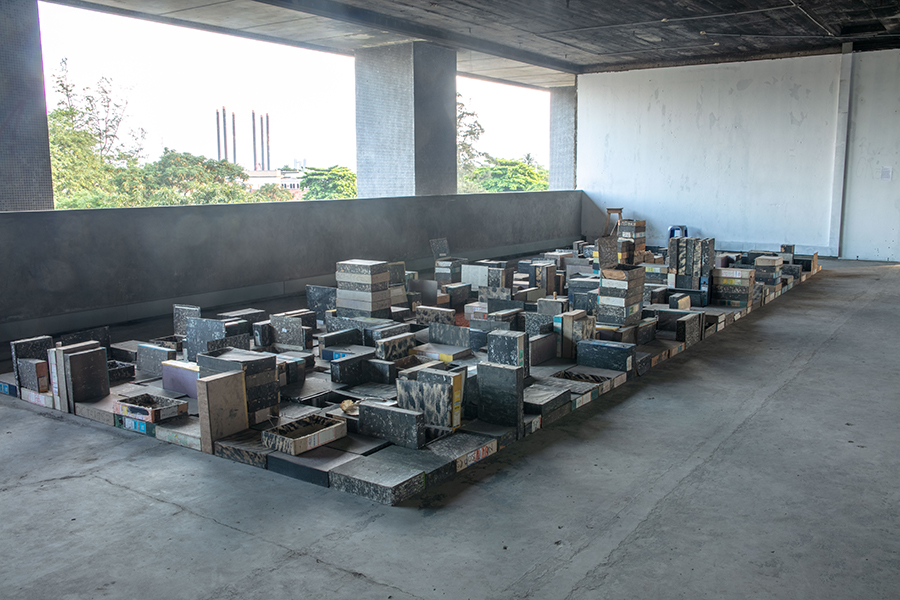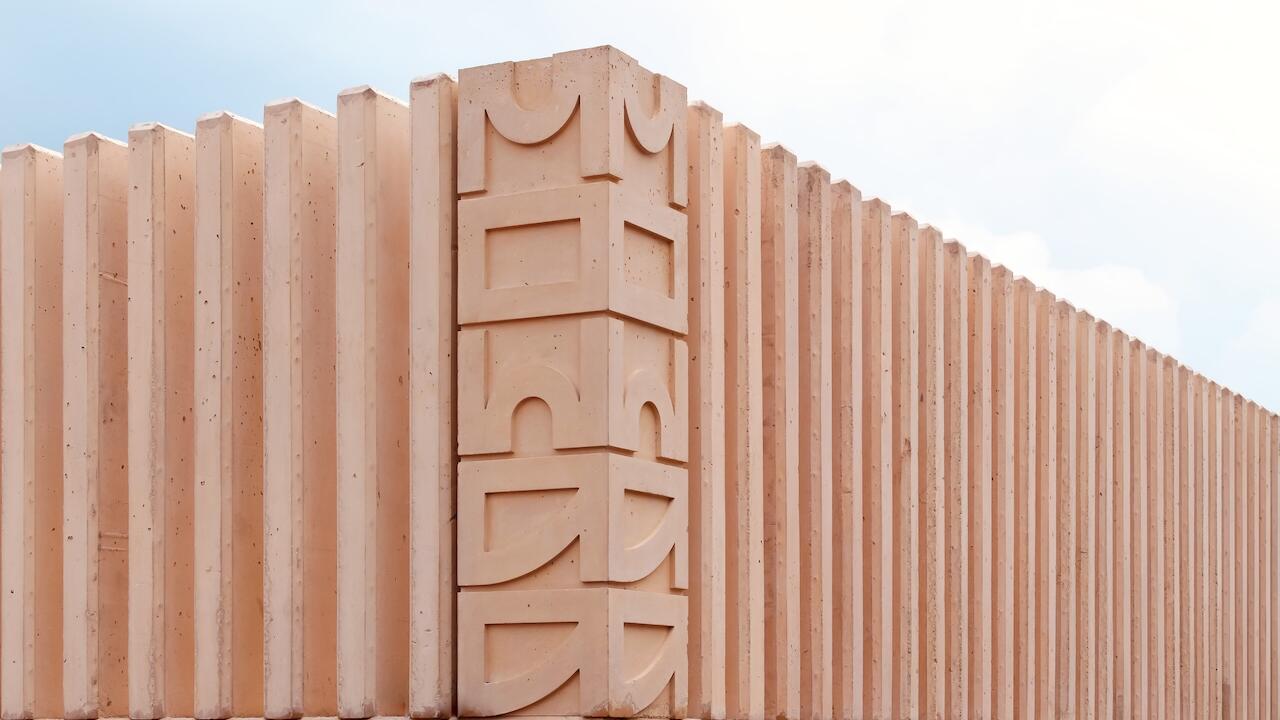Building a Future from the Rubble: The Second Lagos Biennial
The provocative and politically prescient exhibition grapples with hard truths and traumatic histories
The provocative and politically prescient exhibition grapples with hard truths and traumatic histories

As I made my way to the first floor of the Independence House, where the second edition of the Lagos Biennial is located, I could hear jubilant Pentecostal praises emanating from a dark room, adjacent to a dusty stairwell, that had been turned into a church. Only there, on a Sunday in Nigeria’s cultural capital, could such seemingly disparate spaces coexist. The Independence House, at one point the country’s tallest skyscraper, was ‘gifted’ by the British upon the (nominal) termination of colonial ties in 1960 and has sat abandoned since a fire in 1993. Curated by Antawan Byrd, Tosin Oshinowo, and Oyinda Fakeye, the Biennial’s second edition ‘How To Build A Lagoon With Just A Bottle Of Wine?’ – featuring more than 40 local and international artists – borrows its title from the poem ‘A Song for Lagos’ by the Nigerian writer Akeem Lasisi. The prompt is apt for a city whose residents know all too well the necessity of doing more with less.

One of the most striking features of the Biennial is its eschewal of the pristine ‘white cube’ aesthetic. Moving through different rooms, I was continuously exposed to the humid breeze, the unrelenting heat, and the urban symphony of traffic as okadas and kekes whizzed by. Raul Jorge Gourgel and Sandra Poulson’s installation, Plastic Broken Chairs, Juxtaposed (2019), which is composed of eight suspended red dresses that respond to the wind’s gentle movement, evokes the ghostly sensation of absent bodies in the long-abandoned site.
Nearby, Andréas Lang’s photographic installation, Lagos. A Story of Disappearance (2019), addresses the local government’s reckless treatment of historic buildings in Lagos Island’s Brazilian Quarters – an area populated by descendants of freed Brazilian slaves that returned to the city in the 19th century. The photographs are directly applied to a wooden surface in a seemingly haphazard manner, with their glossy adhesive and hardened creases left visible, resembling bills that cover the area’s many ageing buildings. In one photograph, a statue of Herbert Macaulay – one of Nigeria’s leading historic anti-colonialists – hovers above a woman walking on a decaying sidewalk wearing traditional iro and buba. This is one of many moments in the Biennial in which the colonial past presses into the postcolonial present.

In another room, Ade and Tolu Coker interrogate the complexities of diasporic identity informed by their British-Nigerian experience. Combining photography, video, and tapestry, the artists document their London-based Black communities with a personal, emotive charge. Adeyemi Michael’s installation Entitled (2019) similarly reflects on Black Britishness and parental migratory narratives through a slide projection of family photos and a surreal short video. In a section of the installation, a pair of his mother’s purple, low-heeled shoes dangle above 32 elegantly tied geles (each gele, a traditional head wrap, representing one year his mother has spent outside Nigeria). The suspended shoes symbolise the African migrant’s refusal to ‘stay put’ – a defiant exercise in free movement despite growing xenophobia worldwide. My eyes return to the building’s weathered concrete interior, its state-administered decay offering clues as to what might have prompted the country’s mass emigrations, beginning in the 1980s.
Other spectres are unleashed in Dane Komljen’s The Seven Elements (2019). Komljen has arranged 14 images on a wall, each one presenting an aerial view of a site occupied by grand, interlocking geometric structures – reminiscent of the utopian aspirations of Brutalism. The artist’s hand-written historical narration, which has the didactic appearance of white chalk, reveals that these modernist buildings comprise the Lagos Trade Fair Complex, and were constructed by Yugoslavian architects in the 1970s. A physical remnant of Non-Alignment solidarity (a forum of developing countries initially created to refuse formal alignment with either the United States or the Soviet Union), these edifices – abandoned for about three decades – triangulate the histories of architectural modernism, anti-colonialism and the Cold War. By allowing viewers to inscribe their own responses on the wall with chalk, Komljen’s work not only explores how these entangled histories lay repressed within postcolonial urban space, but also opens up a dialogue regarding how we might rework and reroute such histories.

On the second floor, in A History of a City in a Box (2019), Ndidi Dike has transformed old wooden file boxes that she salvaged from the building into a dense arrangement of blocks, evoking the layout of the nearby Marina business district. She has left some file cabinets open, exposing governmental receipts and documents from the 1980s, and partially covered some archival photographs – depicting Lagos streets and buildings – in varying tones of found earth. The work poignantly critiques how the Nigerian state exerts power through the strategic concealment of information. The moving installation also stages a metaphorical burial of Lagosian collective memory, its deteriorating folders symbolising the slow rot of a wounded, stultified, ex-colonised body.
Adjacent to Dike’s work is Uthman Wahaab’s large monochromatic drawing, Back With me Again (2019), which seamlessly weaves multiple scenes into a cohesive visual narrative. Wahaab’s draughtsmanship is made highly apparent through his skilful rendering of light, shadow and human flesh. Each centred around a full-bodied female figure commanding a social or civic event, the work channels a fervent feminist impulse by critiquing both female beauty standards and the socio-political marginalisation of Nigerian women. Also sensitively attuned to concerns of gender and sexuality is Sabelo Mlangeni’s photographic installation, The Royal House of Allure (2019). Installed on a bright pink wall, Mlangeni documents a safe social space where queer Lagosians gather to express themselves and support one another. In one of the vivid photographs, a man wearing high-heeled shoes strikes a fierce pose and assertively returns the viewer’s gaze, countering the country’s repressive regime of queer erasure with a single, strident gesture.

On the third and final floor, Abraham Oghobase and Katrin Winkler’s respective photo-conceptual installations make for an exceptionally strong pairing. In Oghobase’s Constructed Realities (2019), fragments of colonial archival imagery collide with administrative texts from The Dual Mandate in British Tropical West Africa, written by Nigeria’s first governor-general, Lord Frederick Lugard, in 1922. Oghobase incisively reveals the ideological limitations of colonial rhetoric, mobilising the aesthetic surplus of the archival image to obscure and ultimately undermine the stability of Lugard’s authoritative text. Winkler’s work, Pass It On and She Will Know (2019), further undoes the epistemic authority of official historical narratives by employing the emancipatory potential of fiction and abstraction. The artist pairs ambiguous digital photomontages with imagined conversations between women – equally open-ended in their poeticism – strategizing for the 1929 Women’s War. Like Oghobase, Winkler identifies the liminal space between text and imagery as a site where the past can be revisited and future possibilities can be imagined.
Before departing the Biennial, I passed a lush mosaic by Yusuf Grillo, one of the country’s most admired modernists. Completed in 1961, the mosaic has since fallen into disrepair, just like the building it adorns. From there, I could see the towering light poles of Tafawa Balewa Arena, the stadium that hosted the Nigerian independence celebrations and the vibrant rallies of FESTAC ’77. That bygone era of postcolonial optimism feels like a distant, utopic dream now, as the country ricochets from one crisis to another. Fortunately, the second edition of the Lagos Biennial, with its critical, historically reflexive and counter-hegemonic stance, invites us to think about what alternative futures can be built from the rubble.
The Lagos Biennial II was presented at Independence House, Lagos, Nigeria, from 26 October to 23 November 2019.
Main image: Sabelo Mlangeni, The Royal House of Allure, 2019, installation view. Courtesy: the artist and Lagos Biennial; photograph: Kola Oshalusi





















